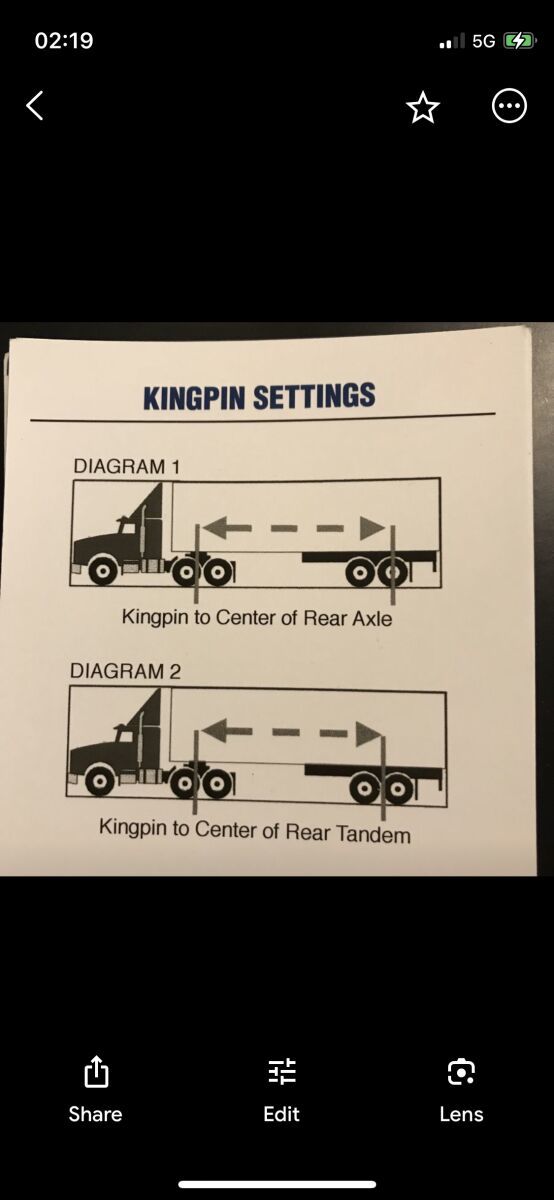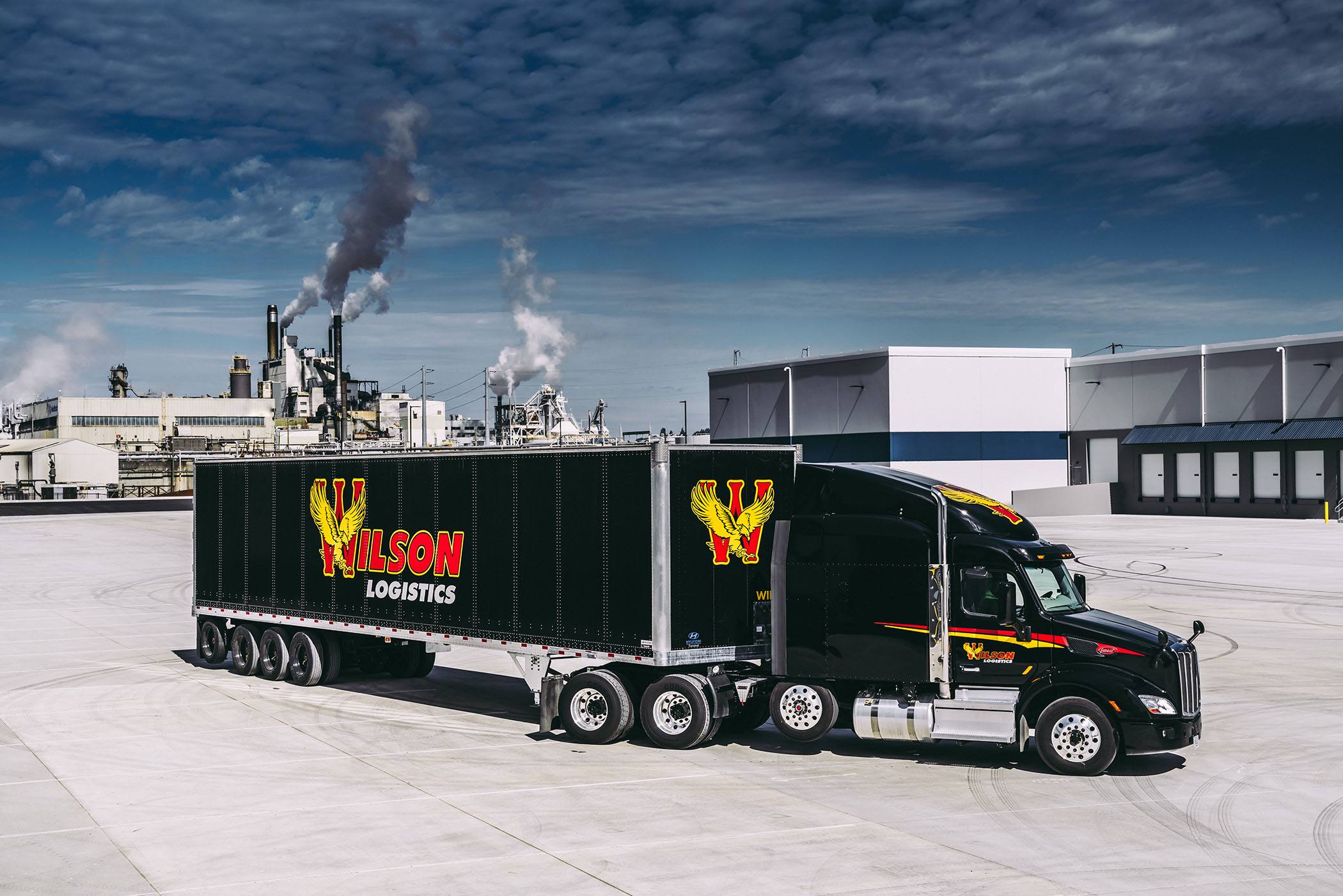How Far Back Can Your Tandems Go And Be Legal To Drive?
Topic 33748 | Page 1
It all depends on the state you are traveling in. Some states you can put them in any position. Axle weights, length, and gross weight will dictate where these are adjusted to. Your trainer was incorrect.
Pelican, your trainer is confused or not very well educated in the details. I don't know where the arrow on your trailer is placed, but I'd be willing to wager that it marks where you're legal in California. There are a lot of states that don't care how far back your tandems are.
Most professional truckers educate themselves on the various rules applicable to them. You've started that process with this very good question. BK mentioned the Rand McNally motor carriers Atlas. You need one on your truck. It has answers to all your questions concerning tandem positions.
I very seldom go West of the Rockies, but I know the rules well for the many states I run. Use that section of the Atlas when you are trip planning. It has what you need.
If your trainer taught you to just plug in an address in the GPS and take off, you've got work to do to help you learn how to do this like a professional. I'm glad you posed the question. It shows you want to learn more. Keep up the good work.
Tandems:
Tandem Axles
A set of axles spaced close together, legally defined as more than 40 and less than 96 inches apart by the USDOT. Drivers tend to refer to the tandem axles on their trailer as just "tandems". You might hear a driver say, "I'm 400 pounds overweight on my tandems", referring to his trailer tandems, not his tractor tandems. Tractor tandems are generally just referred to as "drives" which is short for "drive axles".
Tandem:
Tandem Axles
A set of axles spaced close together, legally defined as more than 40 and less than 96 inches apart by the USDOT. Drivers tend to refer to the tandem axles on their trailer as just "tandems". You might hear a driver say, "I'm 400 pounds overweight on my tandems", referring to his trailer tandems, not his tractor tandems. Tractor tandems are generally just referred to as "drives" which is short for "drive axles".
Dang. The issue was I was at 35,600 lbs on my tandems and that was with them all the way to the arrow.
My assumption was that was as far as I could go back so they ended up having to take a pallet off my truck so the weight wouldn't be so heavy on my tandems.
My buddy said I could have just slid them all the way back. Now I know.
Pelican, your trainer is confused or not very well educated in the details. I don't know where the arrow on your trailer is placed, but I'd be willing to wager that it marks where you're legal in California. There are a lot of states that don't care how far back your tandems are.
Most professional truckers educate themselves on the various rules applicable to them. You've started that process with this very good question. BK mentioned the Rand McNally motor carriers Atlas. You need one on your truck. It has answers to all your questions concerning tandem positions.
I very seldom go West of the Rockies, but I know the rules well for the many states I run. Use that section of the Atlas when you are trip planning. It has what you need.
If your trainer taught you to just plug in an address in the GPS and take off, you've got work to do to help you learn how to do this like a professional. I'm glad you posed the question. It shows you want to learn more. Keep up the good work.
Tandems:
Tandem Axles
A set of axles spaced close together, legally defined as more than 40 and less than 96 inches apart by the USDOT. Drivers tend to refer to the tandem axles on their trailer as just "tandems". You might hear a driver say, "I'm 400 pounds overweight on my tandems", referring to his trailer tandems, not his tractor tandems. Tractor tandems are generally just referred to as "drives" which is short for "drive axles".
Tandem:
Tandem Axles
A set of axles spaced close together, legally defined as more than 40 and less than 96 inches apart by the USDOT. Drivers tend to refer to the tandem axles on their trailer as just "tandems". You might hear a driver say, "I'm 400 pounds overweight on my tandems", referring to his trailer tandems, not his tractor tandems. Tractor tandems are generally just referred to as "drives" which is short for "drive axles".
Remember, Pelican, on most trucks you can actually slide your fifth wheel a bit to balance the axles. That's what the lock pins and the small square holes are all about on the fifth wheel.
But I feel that's mostly more trouble than its worth. I once had a load making the truck weight 79,920 and my front axle was 34,120. I rolled with that, and the scale house still gave me a green arrow out. I think it was sorta like going 52 on a 45 MPH road.
Where was the load going to/ through? As was said different states have different regulations and lengths allowed. Typically that arrow is at the 40' mark (measured from the kingpin). But not knowing the trailer I couldn't say for sure.
This can be a really good learning experience for your trip planning skills.
Know you're route, the states you're going through and the lengths you have be at before you get to the shipper. Know your weather on the route, terrain, entry/exit to shipper n reciever as well a ballpark of how far youll run each day and parking for the night. Ideally when you get the preplan is the time to plan your trip. That way you can identify possible issues and solve/communicate promptly.
Shipper:
The customer who is shipping the freight. This is where the driver will pick up a load and then deliver it to the receiver or consignee.
OWI:
Operating While Intoxicated
These are handy references for king pin laws by state. My company’s trailers have stickers on them listing the states with max hole back rules.
I run in the Midwest a lot so frequently use 12th hole back as maximum. I find that 12th hole usually provides good balance between drives and tandems weight distribution.
Be careful about Indiana rule on state highways being 7th hole max back rather than 12th.
I have had to have 3 trailers reworked by one shipper running from Michigan to Tennessee when tandem was overweight in the 12th hole max back. Usually take a couple pallets off.



Shipper:
The customer who is shipping the freight. This is where the driver will pick up a load and then deliver it to the receiver or consignee.
Tandems:
Tandem Axles
A set of axles spaced close together, legally defined as more than 40 and less than 96 inches apart by the USDOT. Drivers tend to refer to the tandem axles on their trailer as just "tandems". You might hear a driver say, "I'm 400 pounds overweight on my tandems", referring to his trailer tandems, not his tractor tandems. Tractor tandems are generally just referred to as "drives" which is short for "drive axles".
Tandem:
Tandem Axles
A set of axles spaced close together, legally defined as more than 40 and less than 96 inches apart by the USDOT. Drivers tend to refer to the tandem axles on their trailer as just "tandems". You might hear a driver say, "I'm 400 pounds overweight on my tandems", referring to his trailer tandems, not his tractor tandems. Tractor tandems are generally just referred to as "drives" which is short for "drive axles".

In most places, there are laws about how far back you can slide your tandems on a trailer. These laws are there to make sure the weight on the trailer is balanced right and safe for driving. Usually, trailers have a mark or an arrow that shows the farthest point you can slide your tandems back to. Your trainer is right that in many places, you can only go as far back as the middle of your hubseal on your rear axle under that line. Going beyond that can be illegal because it affects how well the trailer handles on turns. It's true that in some states, the rules might be different, but generally, it's safer to keep your tandems at or in front of the arrow on your trailer to stay within the legal limits and drive safely.
Tandems:
Tandem Axles
A set of axles spaced close together, legally defined as more than 40 and less than 96 inches apart by the USDOT. Drivers tend to refer to the tandem axles on their trailer as just "tandems". You might hear a driver say, "I'm 400 pounds overweight on my tandems", referring to his trailer tandems, not his tractor tandems. Tractor tandems are generally just referred to as "drives" which is short for "drive axles".
Tandem:
Tandem Axles
A set of axles spaced close together, legally defined as more than 40 and less than 96 inches apart by the USDOT. Drivers tend to refer to the tandem axles on their trailer as just "tandems". You might hear a driver say, "I'm 400 pounds overweight on my tandems", referring to his trailer tandems, not his tractor tandems. Tractor tandems are generally just referred to as "drives" which is short for "drive axles".
New Reply:
New! Check out our help videos for a better understanding of our forum features

















Preview:








 TT On Facebook
TT On Facebook
I had a situation recently where I was overweight on my tandems.
Our trailers have a big arrow at the back that shows the maximum you can slide your tandems back to.
Trainer said you can only go as far as the middle of your hubseal on your real axle under that line, past that driving around is illegal.
I was talking to my buddy he said no, you could technically drive around with your tandems as far back as necessary, it just makes turning a lot harder.
So is there a limit to how far your tandems can be when driving down the roads or no?
I know some states have laws regarding this. I've always kept my tandems at or in front of the arrow.
Tandems:
Tandem Axles
A set of axles spaced close together, legally defined as more than 40 and less than 96 inches apart by the USDOT. Drivers tend to refer to the tandem axles on their trailer as just "tandems". You might hear a driver say, "I'm 400 pounds overweight on my tandems", referring to his trailer tandems, not his tractor tandems. Tractor tandems are generally just referred to as "drives" which is short for "drive axles".
Tandem:
Tandem Axles
A set of axles spaced close together, legally defined as more than 40 and less than 96 inches apart by the USDOT. Drivers tend to refer to the tandem axles on their trailer as just "tandems". You might hear a driver say, "I'm 400 pounds overweight on my tandems", referring to his trailer tandems, not his tractor tandems. Tractor tandems are generally just referred to as "drives" which is short for "drive axles".